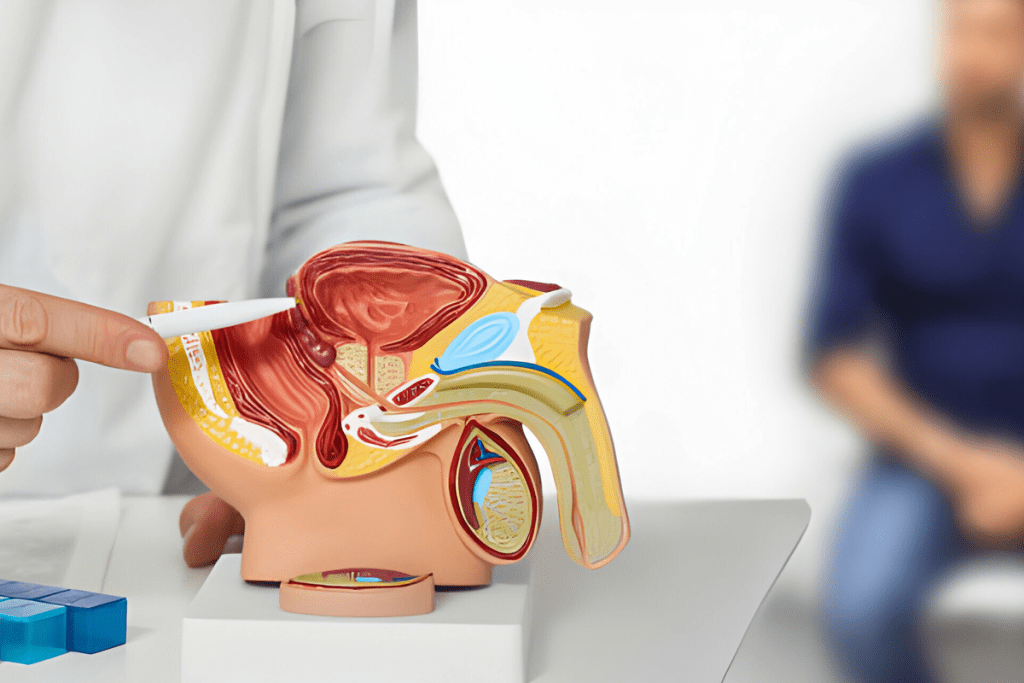Last Updated on October 31, 2025 by
When it comes to treating an enlarged prostate, or benign prostatic hyperplasia (BPH), the best flomax treatment depends on several factors. These include the severity of symptoms, the size of the prostate gland, and what the patient prefers.
We focus on what’s best for each patient. Recent studies suggest that prostate artery embolization (PAE) is a top choice for a minimally invasive treatment.

PAE works by cutting off the blood supply to the prostate gland. This makes the gland smaller and relieves symptoms. It’s great for men with big prostates or those who can’t have surgery.
As men get older, the chance of getting Benign Prostatic Hyperplasia (BPH) goes up. It’s key to know its signs and treatment choices. BPH is when the prostate gland gets bigger, which can really change a man’s life.

The signs of BPH can really mess with your day and sleep. You might have trouble starting or stopping to pee, or pee a lot, even at night. These issues can make you tired, less productive, and feel really bad.
For example, needing to pee at night can mess up your sleep. This can lead to not getting enough sleep and health problems. Men with these symptoms should see a doctor to feel better and avoid bigger problems.
BPH gets worse over time if not treated. As the prostate grows, it can press on the urethra, making pee problems worse. If symptoms are mild, watchful waiting or simple changes might help. But if symptoms bother you a lot or affect your daily life, you need treatment.
It’s important to keep an eye on BPH symptoms and get help if they get worse or are really hard to handle. Getting help early can make symptoms easier to manage and prevent serious problems like infections, stones, and kidney damage.
The success of BPH treatment depends on several important factors. We carefully look at these elements to find the best treatment plan. Understanding these factors is key when managing Benign Prostatic Hyperplasia.
The size of the prostate gland is a big factor in choosing treatment. A larger prostate might need more serious treatments, like surgery or minimally invasive procedures like Prostate Artery Embolization (PAE). On the other hand, a smaller prostate might be treated with medication or careful monitoring. The Mayo Clinic says prostate size is very important in picking the right BPH treatment.

The severity of BPH symptoms greatly affects a patient’s quality of life. Symptoms like needing to urinate often, weak urine flow, and waking up to urinate can be very hard to deal with. We look at how bad these symptoms are to suggest treatments that help and make the patient feel better. For example, alpha-blockers can relax the prostate muscles, making it easier to urinate.
A patient’s age and health are also important in treatment success. Older patients or those with health problems might need treatments that are less invasive or have fewer side effects. We look at the patient’s health to make sure the treatment is right for them, ensuring it works well and is safe.
By looking at prostate size, symptom severity, patient age, and health status, we can create a treatment plan that meets each patient’s needs. This personalized approach helps ensure successful treatment outcomes and improves the patient’s quality of life.
Men with an enlarged prostate find relief with medications like Flomax. These drugs help manage Benign Prostatic Hyperplasia (BPH). They improve symptoms and quality of life.
Alpha blockers, like Flomax (tamsulosin), relax the prostate and bladder muscles. This makes urination easier. Flomax is known for its effectiveness in improving urine flow and reducing BPH symptoms.
These medications work in a similar way but have different side effects. Flomax has a better side effect profile than some others.
5-alpha reductase inhibitors, like finasteride and dutasteride, shrink the prostate over time. This is beneficial for men with larger prostates.
Combining an alpha blocker with a 5-alpha reductase inhibitor can be recommended. This offers quick relief and long-term prostate size reduction.
The time it takes for symptoms to improve varies. Alpha blockers like Flomax show benefits in days to weeks. 5-alpha reductase inhibitors take months to fully work.
It’s important to talk to a healthcare provider about these medications. They can help choose the best treatment for BPH.
Men with Benign Prostatic Hyperplasia (BPH) symptoms now have a new hope. Prostate Artery Embolization (PAE) is a minimally invasive treatment. It reduces the prostate size and relieves symptoms, improving life quality.
PAE blocks the blood supply to the enlarged prostate. This makes the gland smaller and eases urinary symptoms. Studies show PAE is very effective, improving symptoms and life quality for men with BPH.
Cedars-Sinai notes PAE’s success in clinical trials. It’s a good option for men wanting to avoid surgery.
PAE has a short recovery time. Most men can go back to their normal activities in just a few days. This quick recovery is thanks to PAE’s minimally invasive nature.
PAE is great for men with big prostates. Traditional surgery can be risky for them. PAE offers a safer, less invasive option, improving their quality of life.
Preserving sexual function is a big concern for men with BPH. PAE is known for its low risk of sexual dysfunction. This is important for men who want to keep their sexual health.
We’re dedicated to the latest in care, including PAE. We aim to provide top-notch healthcare, meeting our patients’ unique needs.
Men with BPH face a big decision: which surgical or advanced intervention to choose. Each option has its own benefits and risks. It’s all about finding the best fit for improving life quality.
TURP is a common surgery for BPH that can greatly help symptoms. But, it also comes with risks like incontinence and erectile issues. Studies show it’s effective, but its downsides need careful thought.
Key Considerations for TURP:
Aquablation is a new, less invasive method using water jets to remove prostate tissue. It’s great because it often keeps sexual function intact. Preserving sexual function is a big plus for many.
Benefits of Aquablation:
Laser treatments use lasers to remove prostate tissue. They offer unique benefits and risks compared to TURP and aquablation.
“Laser therapies have emerged as a valuable treatment option for BPH, balancing efficacy and safety.” – Expert Opinion
Key Features of Laser Therapies:
Knowing the differences between TURP, aquablation, and laser therapies helps patients and doctors make better choices for BPH treatment.
Choosing the right treatment for Benign Prostatic Hyperplasia (BPH) is all about personal care. We focus on understanding each patient’s unique situation. This approach helps us tailor the treatment to fit their needs and health.
The best treatment for BPH varies from person to person. It depends on the size of the prostate, how bad the symptoms are, and the patient’s overall health. We explore all options, from medicines like Flomax to procedures like Prostate Artery Embolization (PAE) and surgery. This way, patients can choose what works best for them.
We are dedicated to giving men with BPH the care they need to live better lives. By choosing treatments that match each patient’s specific needs, we aim for the best results. Our goal is to improve the quality of life for all our patients.
BPH, or enlarged prostate, is common in older men. It makes the prostate gland grow. This can block the urethra, causing urinary problems.
Symptoms include a weak urine stream and trouble starting or stopping. You might also need to urinate often, even at night. If these problems get worse, see a doctor.
The prostate’s size affects treatment choices. A bigger prostate might need more serious treatments. Smaller ones might just need medicine or waiting.
Alpha blockers, like Flomax, relax prostate muscles. This makes it easier to urinate. They work fast, often in days or weeks.
PAE is a new, less invasive method. It blocks blood to the prostate, shrinking it. It’s good for large prostates or those avoiding surgery.
PAE is great because it usually doesn’t harm sexual function. This is a big plus for men worried about surgery’s effects.
TURP is a proven surgery for BPH. But, it can cause problems like incontinence and erectile issues.
Aquablation uses water jets to remove prostate tissue. It’s new and keeps sexual function in many men. It’s a promising option for BPH.
Choosing the right treatment is personal. It depends on your prostate size, symptoms, and health. We tailor treatments to improve your life.
Yes, PAE is a new, effective treatment. We offer the latest options, like PAE, to our patients.
Yes, BPH can be managed with medicine, lifestyle changes, or waiting. Alpha blockers and 5-alpha reductase inhibitors are common treatments. The best choice depends on your situation.
Subscribe to our e-newsletter to stay informed about the latest innovations in the world of health and exclusive offers!